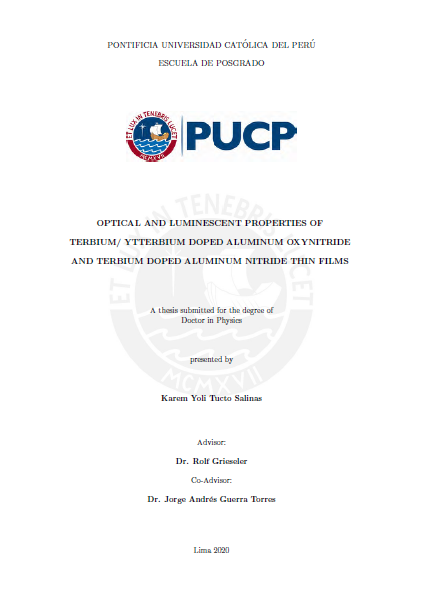Optical and luminiscent properties of terbium / ytterbium doped aluminum oxynitride and terbium doped aluminum nitride thin films
Abstract
In the present thesis the optical and light emission properties of two systems consisting of Tb3+ and Yb3+ doped amorphous AlOxNy thin films and Tb3+ doped polycrystalline AlN thin films were analyzed. In the two ions system, to obtain an adequate luminescent emission, commonly a significant effort must be made to find a suitable concentration of dopants and elemental composition of the host material. An interesting and highly efficient method is a combinatorial approach, allowing a high velocity screening of a wider range of properties. In the present work a combinatorial gradient based thin film libraries of amorphous AlOxNy:Yb3+, AlOxNy:Tb3+ and AlOxNy:Tb3+:Yb3+ have been prepared by radio frequency co-sputtering from more than one target. In the prepared libraries, the Tb and Yb concentration range spreads along with the oxygen to nitrogen ratio of the host matrix all over the substrate area. Concentrations ranges for each ion were established for producing high emission intensity samples, along with an analysis of the light emission features of Yb3+ ions with Tb3+ ions as sensitizers for cooperative down conversion process. Using different annealing temperatures the activation energy of the rare earth ions and thermal-induced activation mechanisms are evaluated. Here we show that the different oxygen to nitrogen ratios in the host composition affect the light emission intensity. According to experimental results, there is a strong enhancement of the Yb3+ related emission intensity over the Tb3+ emission in codoped films with Tb:Yb concentration ratios near to 1:2, at 850°C. Thus, suggesting the sensitization of Tb3+ ions through an AlOxNy matrix and the cooperative energy transfer between Tb3+ and Yb3+ ions as the driven mechanism for down conversion process with promising applications in silicon solar cells. At the end of this first part, the optimal elemental composition and optimal annealing temperature in the investigated ranges to achieve the highest Yb3+ emission intensity upon sensitization of Tb3+ ions is reported. The second system studied consists of Tb3+ doped AlN layers prepared by reactive magnetron sputtering and analyzed using the conventional one at a time approach. In this work, two types of thermal treatments have been applied: substrate heating during deposition of the films and post deposition rapid thermal annealing, with varying temperature from non intentional heating up to 600°C. The composition, morphology and crystalline structure of the films under different thermal processes and temperatures were investigated along with their optical and light emission properties, with the aim of maximizing the Tb3+ emission intensity. The polycrystalline nature of the films was confirmed by X-ray diffraction under grazing incidence, and the influence of substrate temperature on the crystalline structure was reported. Atomic force microscopy and scanning electron microscopy has revealed the smooth grainy surface quality of the AlN:Tb3+ films. The highest Tb3+ photoluminescence emission intensity was achieved in the film treated with rapid thermal annealing process. For a more detailed study of the post deposition annealing treatments, temperature was further increased up to 900°C, and the influence of annealing temperature on the emission properties was investigated by photoluminescence and photoluminescence decay measurements. An increase in the photoluminescence intensity and photoluminescence decay time was observed upon annealing for the main transition of Tb3+ ions at 545 nm, which was attributed to a decrease of non radiative recombination and increase of the population of excited Tb3+ ions upon annealing. Additionally, using the characterized films as active layer, direct current and alternate current thin film electroluminescence devices were designed and investigated.
Temas
Películas delgadas--Análisis estructural
Películas delgadas--Propiedades ópticas
Películas delgadas--Propiedades ópticas
Para optar el título de
Doctor en Física
Collections
The following license files are associated with this item:






